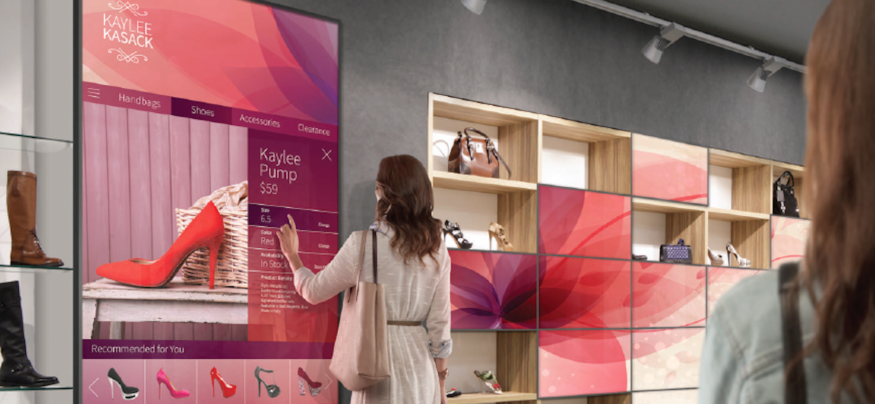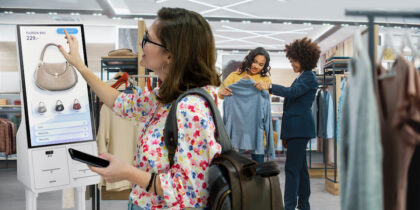Today’s digitally-driven shopping experience is forcing retailers to adopt the newest innovations to better engage customers throughout their digital path to purchase. However, unless retailers can transform physical locations into “connected stores” via digital touch points that attract shoppers, customer engagement will remain a pipe dream.
The all-channel retail experience is defined by the integration of business channels and customer-facing engagement devices that span conventional point-of-sale (POS), payment and computer terminals to more emerging solutions, such as Web-based in-store kiosks, digital signage and mobile devices, among others. Digital touch points are so critical to the omnichannel consumer’s journey that 84 percent of shoppers used a combination of solutions before or during their most recent trip to a store, a factor that influenced 36 percent, or $1.1 trillion of in-store retail sales, according to Deloitte’s report, “The New Digital Divide.”
True success stories will be driven by retailers that create “connected stores” that deliver a unified experience across a brand, regardless of the channel they utilize to make a purchase decision. The following brands are currently making waves — and connecting with shoppers — using these retail hubs:
Rebecca Minkoff
A pioneer in how to merge the online and physical shopping experience through cutting-edge technology, the designer’s flagship New York City store uses many innovations to bring its aesthetic and fashions to life. A “connected wall” enables shoppers to view and select their preferred looks, while fitting rooms are outfitted with touch-screen mirrors that recognize RFID-tagged merchandise, including product sizes and colors. A simple touch of the mirror enables shoppers to submit size and product requests to store associates. It also blends e-commerce, displaying recommendations, product details, ratings and reviews while saving merchandise chosen during a fitting room session.
Finally, a mobile app allows shoppers to check-in to the store, navigating their store visit. This in-store check-in pushes the shopper’s personal profile to all Rebecca Minkoff store channels, a move that helps store associates provide a more personal, customized experience throughout the visit.
Perry Ellis
The brand may be 40 years old, but Perry Ellis’ focus on customer engagement is nothing short of innovative. Called its “Shop of the Future,” Perry Ellis features an immersive, technology-driven store-within-a-store concept in Macy’s Herald Square men’s department. Utilizing digital technology and tools designed to captivate shoppers, this concept is developing into a shopping destination that tells the Perry Ellis brand story. Divided into three sections, non-angular walls invite guests to engage with interactive, floating mirrors embedded with proximity sensors designed to greet approaching customers with responsive and personalized content. Meanwhile, curved walls provide a modern storytelling platform through the use of custom LED hardware. The private space also features phone charging stations.
Oscar Feldenkreis, president and chief operating officer for Perry Ellis, reported in MR Magazine that they had wanted to create something to draw in new customers while continuing to resonate with their existing core shoppers. He said that adding a tech component to their shoppers’ experience was an inherently natural way to accomplish that primary goal, explaining that proximity sensors created a futuristic-feel to the space while remaining user-friendly, and the digital platform gave Perry Ellis the means to communicate in a more contemporary voice.
Kate Spade
A brand known for crisp colors and playful, graphic prints across handbags, apparel and accessories, Kate Spade New York uses innovative, interactive multimedia displays to engage shopper within its stores. A mix of imagery, touch screens and merchandise collection are featured in display cases, both inside and outside of the store. In addition to these store windows, customers navigate among individual walls that also feature interactive solutions, including touch screens, that provide custom product recommendations, local sights to see, books to read and music to listen to.
While in-store, shoppers are invited to take short, clever quizzes centered around personality traits and style preferences. Results are sent to their mobile devices, along with a personalized statement that celebrates the shopper as an individual. The brand also encourages shoppers to share this prose across their own social media platforms.
Kate Spade uses this information and purchase data to curate customized collections unique to individual customers’ tastes and delivers them to their mobile devices, along with complimentary, one-day shipping to further drive sales. “Our overall brand experience goes beyond selling. We are always looking for unique, interesting ways to tell our brand story,” said Kate Spade & Company chief marketing officer, Mary Beech. “This technology has a personal touch, and allows us to begin our conversation with shoppers before we do so in person when the stores open.”
These examples prove the importance of embracing digital touch points. Brands that can successfully make the transition will learn how to service and retain the 21 century’s “connected customer.”
Learn more about the solutions that are enabling retail brands to transform the modern consumer experience through technology.







